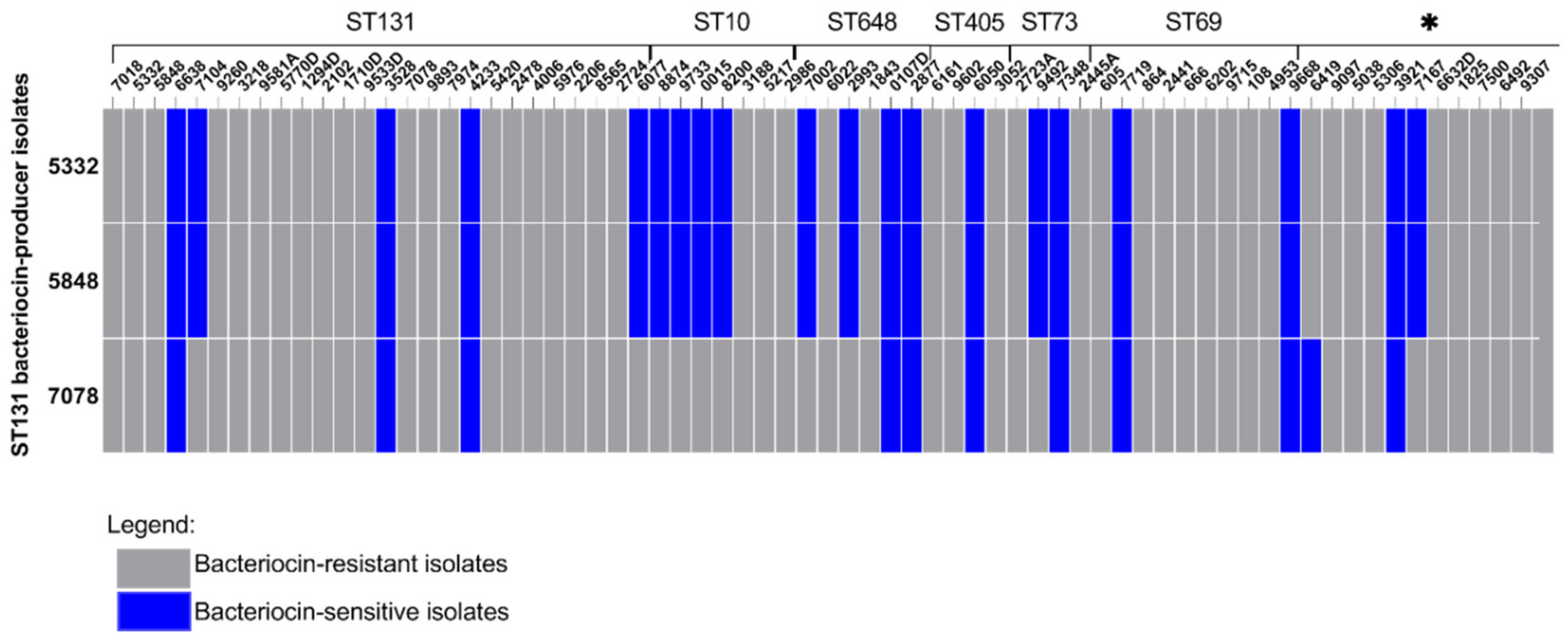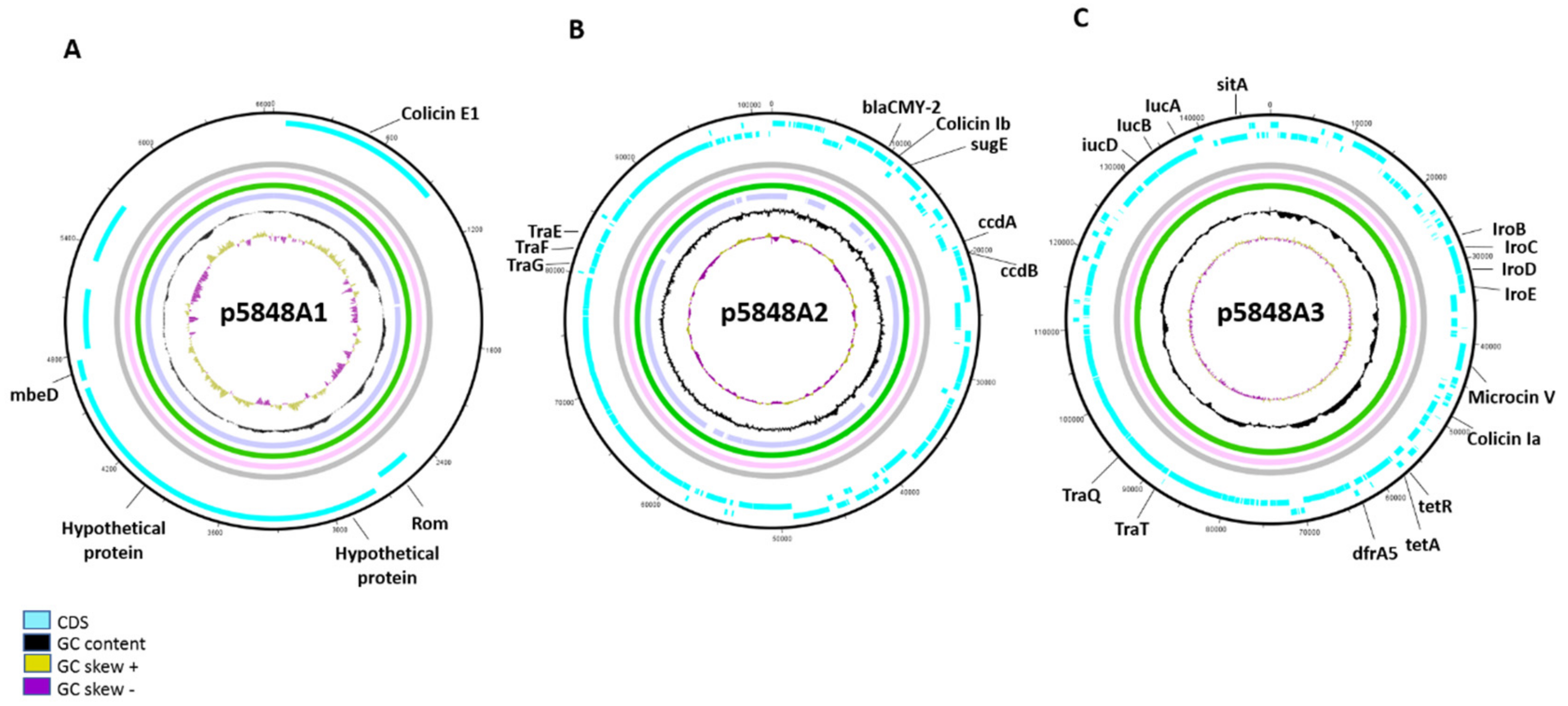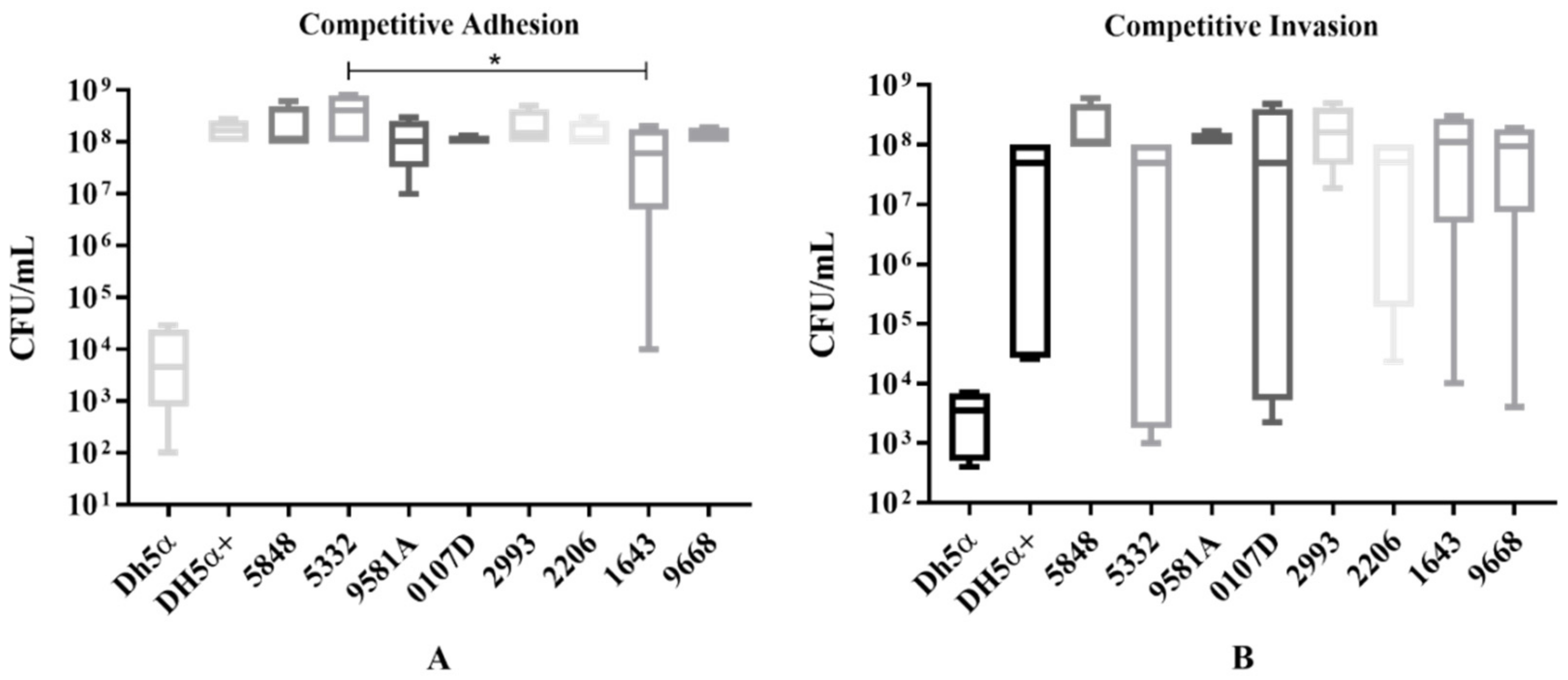Determining the Virulence Properties of Escherichia coli ST131 Containing Bacteriocin-Encoding Plasmids Using Short- and Long-Read Sequencing and Comparing Them with Those of Other E. coli Lineages
Abstract
1. Introduction
2. Materials and Methods
2.1. Bacterial Isolates and Bacteriocin Activity Assay
2.2. Short-Read Sequencing
2.3. Long-Read Sequencing
2.4. Assembly, Annotation and Analysis
2.5. Plasmid Analysis and Identification of Bacteriocin Genes
2.6. Bacterial Transformation Assay
2.7. Competition Adhesion and Invasion Experiments
2.8. Competition Fitness Assay
2.9. Statistical Analysis
2.10. Ethical Considerations
3. Results
3.1. Bacterial Isolates and Bacteriocin Sensitivity Profile
3.2. Distribution of Bacteriocin Genes among Clinical Isolates
3.3. Association between Phylogenetic Group, Virulence Genes, MDR and Bacteriocins Genes
3.4. Identification and Characterization of Plasmids Present in ST131 Isolates
3.5. Bacterial Fitness Cost and Predicted Transfer Potential
3.6. Bacteriocin-Encoding Plasmids and Phenotypical Virulence Profile
4. Discussion
5. Conclusions
Supplementary Materials
Author Contributions
Funding
Acknowledgments
Conflicts of Interest
References
- Poolman, J.T.; Wacker, M. Extraintestinal pathogenic Escherichia coli, a common human pathogen: Challenges for vaccine development and progress in the field. J. Infect. Dis. 2016, 213, 6–13. [Google Scholar] [CrossRef]
- Micenková, L.; Bosák, J.; Vrba, M.; Ševčíková, A.; Šmajs, D. Human extraintestinal pathogenic Escherichia coli strains differ in prevalence of virulence factors, phylogroups, and bacteriocin determinants. BMC Microbiol. 2016, 16, 1–8. [Google Scholar] [CrossRef] [PubMed]
- Barber, A.E.; Norton, J.P.; Spivak, A.M.; Mulvey, M.A. Urinary tract infections: Current and emerging management strategies. Clin. Infect. Dis. 2013, 57, 719–724. [Google Scholar] [CrossRef] [PubMed]
- Köhler, C.D.; Dobrindt, U. What defines extraintestinal pathogenic Escherichia coli? Int. J. Med Microbiol. 2011, 301, 642–647. [Google Scholar] [CrossRef] [PubMed]
- Yang, S.C.; Lin, C.H.; Sung, C.T.; Fang, J.Y. Antibacterial activities of bacteriocins: Application in foods and pharmaceuticals. Front. Microbiol. 2014, 5, 1–10. [Google Scholar]
- Smaoui, S.; Elleuch, L.; Bejar, W.; Karray-Rebai, I.; Ayadi, I.; Jaouadi, B.; Mathieu, F.; Chouayekh, H.; Bejar, S.; Mellouli, L. Inhibition of fungi and Gram-negative bacteria by bacteriocin BacTN635 produced by Lactobacillus plantarum sp. TN635. Appl. Biochem. Biotechnol. 2010, 162, 1132–1146. [Google Scholar] [CrossRef]
- Inglis, R.F.; Bayramoglu, B.; Gillor, O.; Ackermann, M. The role of bacteriocins as selfish genetic elements. Biol. Lett. 2013, 9, 8–11. [Google Scholar] [CrossRef]
- Micenková, L.; Štaudová, B.; Bosák, J.; Mikalová, L.; Littnerová, S.; Vrba, M.; Ševčíková, A.; Woznicová, V.; Šmajs, D. Bacteriocin-encoding genes and ExPEC virulence determinants are associated in human fecal Escherichia coli strains. BMC Microbiol. 2014, 14, 1–9. [Google Scholar] [CrossRef]
- Budič, M.; Rijavec, M.; Petkovšek, Ž.; Žgur-Bertok, D. Escherichia coli bacteriocins: Antimicrobial efficacy and prevalence among isolates from patients with bacteraemia. PLoS ONE 2011, 6, e28769. [Google Scholar] [CrossRef]
- Nedialkova, L.P.; Denzler, R.; Koeppel, M.B.; Diehl, M.; Ring, D.; Wille, T.; Gerlach, R.G.; Stecher, B. Inflammation Fuels Colicin Ib-Dependent Competition of Salmonella Serovar Typhimurium and E. coli in Enterobacterial Blooms. PLoS Pathog. 2014, 10, e1003844. [Google Scholar] [CrossRef]
- Bayramoglu, B.; Toubiana, D.; Van Vliet, S.; Inglis, R.F.; Shnerb, N.; Gillor, O. Bet-hedging in bacteriocin producing Escherichia coli populations: The single cell perspective. Sci. Rep. 2017, 7, 1–10. [Google Scholar] [CrossRef] [PubMed]
- Cascales, E.; Buchanan, S.K.; Duche, D.; Kleanthous, C.; Lloubes, R.; Postle, K.; Riley, M.; Slatin, S.; Cavard, D. Colicin Biology. Microbiol. Mol. Biol. Rev. 2007, 71, 158–229. [Google Scholar] [CrossRef] [PubMed]
- Azpiroz, M.F.; Poey, M.E.; Laviña, M. Microcins and urovirulence in Escherichia coli. Microb. Pathog. 2009, 47, 274–280. [Google Scholar] [CrossRef] [PubMed]
- Downing, T. Tackling Drug Resistant Infection Outbreaks of Global Pandemic Escherichia coli ST131 Using Evolutionary and Epidemiological Genomics. Microorganisms 2015, 3, 236–267. [Google Scholar] [CrossRef]
- Gonçalves, L.F.; De Oliveira Martins, P.; De Melo, A.B.F.; Da Silva, R.C.R.M.; De Paulo Martins, V.; Pitondo-Silva, A.; De Campos, T.A. Multidrug resistance dissemination by extended-spectrum β-lactamase-producing Escherichia coli causing community-acquired urinary tract infection in the Central-Western Region, Brazil. J. Glob. Antimicrob. Resist. 2016, 6, 1–4. [Google Scholar] [CrossRef]
- Chérif, T.; Saidani, M.; Decré, D.; Boubaker, I.B. Cooccurrence of Multiple AmpC β-Lactamases in Escherichia coli, Klebsiella pneumoniae, and Proteus mirabilis in Tunisia. Antmicrobial Agents Chemother. 2016, 60, 44–51. [Google Scholar] [CrossRef]
- Pires, J.; Taracila, M.; Bethel, C.R.; Doi, Y.; Kasraian, S.; Tinguely, R.; Sendi, P.; Bonomo, R.A.; Endimiani, A. In Vivo evolution of CMY-2 to CMY-33 β-lactamase in Escherichia coli sequence type 131: Characterization of an acquired extended-spectrum AmpC conferring resistance to cefepime. Antimicrobial Agents Chemother. 2015, 59, 7483–7488. [Google Scholar] [CrossRef]
- Woodford, N.; Turton, J.F.; Livermore, D.M. Multiresistant Gram-negative bacteria: The role of high-risk clones in the dissemination of antibiotic resistance. Fems Microbiol. Rev. 2011, 35, 736–755. [Google Scholar] [CrossRef]
- Mathers, A.J.; Peirano, G.; Pitout, J.D.D. Escherichia coli ST131: The Quintessential Example of an International Multiresistant High-Risk Clone; Elsevier Ltd.: Amsterdam, The Netherlands, 2015; Volume 90, ISBN 9780128022757. [Google Scholar]
- Kudinha, T.; Johnson, J.R.; Andrew, S.D.; Kong, F.; Anderson, P.; Gilbert, G.L. Escherichia coli sequence type 131 as a prominent cause of antibiotic resistance among urinary Escherichia coli isolates from reproductive-age women. J. Clin. Microbiol. 2013, 51, 3270–3276. [Google Scholar] [CrossRef]
- Johnson, T.J.; Danzeisen, J.L.; Youmans, B.; Case, K.; Llop, K.; Munoz-Aguayo, J.; Flores-Figueroa, C.; Aziz, M.; Stoesser, N.; Sokurenko, E.; et al. Separate F-type plasmids have shaped the evolution of the H30 subclone of Escherichia coli sequence type 131. mSphere 2016, 1, e00121–e00216. [Google Scholar] [CrossRef]
- Stokes, H.W.; Gillings, M.R. Gene flow, mobile genetic elements and the recruitment of antibiotic resistance genes into Gram-negative pathogens. Fems Microbiol. Rev. 2011, 35, 790–819. [Google Scholar] [CrossRef] [PubMed]
- Campos, A.C.C.; Andrade, N.L.; Ferdous, M.; Chlebowicz, M.A.; Santos, C.C.; Correal, J.C.D.; Lo Ten Foe, J.R.; Rosa, A.C.P.; Damasco, P.V.; Friedrich, A.W.; et al. Comprehensive Molecular Characterization of Escherichia coli Isolates from Urine Samples of Hospitalized Patients in Rio de Janeiro, Brazil. Front. Microbiol. 2018, 9, 243. [Google Scholar] [CrossRef] [PubMed]
- Aziz, R.K.; Bartels, D.; Best, A.; DeJongh, M.; Disz, T.; Edwards, R.A.; Formsma, K.; Gerdes, S.; Glass, E.M.; Kubal, M.; et al. The RAST Server: Rapid annotations using subsystems technology. BMC Genom. 2008, 9, 1–15. [Google Scholar] [CrossRef] [PubMed]
- Larsen, M.V.; Cosentino, S.; Rasmussen, S.; Friis, C.; Hasman, H.; Marvig, R.L.; Jelsbak, L.; Sicheritz-Pontén, T.; Ussery, D.W.; Aarestrup, F.M.; et al. Multilocus sequence typing of total-genome-sequenced bacteria. J. Clin. Microbiol. 2012, 50, 1355–1361. [Google Scholar] [CrossRef]
- Camacho, C.; Coulouris, G.; Avagyan, V.; Ma, N.; Papadopoulos, J.; Bealer, K.; Madden, T.L. BLAST+: Architecture and applications. BMC Bioinform. 2009, 10, 1–9. [Google Scholar] [CrossRef]
- Loman, N.J.; Quinlan, A.R. Poretools: A toolkit for analyzing nanopore sequence data. Bioinformatics 2014, 30, 3399–3401. [Google Scholar] [CrossRef]
- Wick, R.R.; Judd, L.M.; Gorrie, C.L.; Holt, K.E. Unicycler: Resolving bacterial genome assemblies from short and long sequencing reads. PLoS Comput. Biol. 2017, 13, 1–20. [Google Scholar] [CrossRef]
- Wick, R.R.; Schultz, M.B.; Zobel, J.; Holt, K.E. Bioinformatics applications note Bandage: Interactive visualisation of de novo genome assemblies. Bioinformatics (Oxf. Engl. ) 2015, 31, 3350–3352. [Google Scholar] [CrossRef]
- Sullivan, M.J.; Petty, N.K.; Beatson, S.A. Easyfig: A genome comparison visualizer. Bioinformatics 2011, 27, 1009–1010. [Google Scholar] [CrossRef]
- Carver, T.; Thomson, N.; Bleasby, A.; Berriman, M.; Parkhill, J. DNAPlotter: Circular and linear interactive genome visualization. Bioinformatics 2009, 25, 119–120. [Google Scholar] [CrossRef]
- Montalbán-López, M.; Kuipers, O.P.; Kok, J.; de Jong, A.; van Heel, A.J. BAGEL3: Automated identification of genes encoding bacteriocins and (non-)bactericidal posttranslationally modified peptides. Nucleic Acids Res. 2013, 41, W448–W453. [Google Scholar]
- Zrimec, J.; Lapanje, A. DNA structure at the plasmid origin-of-Transfer indicates its potential transfer range. Sci. Rep. 2018, 8, 1–10. [Google Scholar] [CrossRef] [PubMed]
- Shintani, M.; Sanchez, Z.K.; Kimbara, K. Genomics of microbial plasmids: Classification and identification based on replication and transfer systems and host taxonomy. Front. Microbiol. 2015, 6, 1–16. [Google Scholar] [CrossRef] [PubMed]
- Bloom, M.V.; Freyer, G.A.; Micklos, D.A. Laboratory DNA Sciense: An Introduction to Recombinat DNA Techiniques and Methods of Genome Analysis, 1st ed.; Benjamin/Cummings Pub. Co.: San Francisco, CA, USA, 1996; ISBN 0805330402. [Google Scholar]
- Calhau, V.; Domingues, S.; Ribeiro, G.; Mendona, N.; Da Silva, G.J. Interplay between pathogenicity island carriage, resistance profile and plasmid acquisition in uropathogenic Escherichia coli. J. Med Microbiol. 2015, 64, 828–835. [Google Scholar] [CrossRef]
- Hols, P.; Ledesma-García, L.; Gabant, P.; Mignolet, J. Mobilization of Microbiota Commensals and Their Bacteriocins for Therapeutics. Trends Microbiol. 2019, 27, 690–702. [Google Scholar] [CrossRef]
- Jin, X.; Kightlinger, W.; Kwon, Y.-C.; Hong, S.H. Rapid production and characterization of antimicrobial colicins using Escherichia coli-based cell-free protein synthesis. Synth. Biol. 2018, 3, 1–11. [Google Scholar] [CrossRef]
- Liu, C.M.; Marc, S.; Azziz, M.; Johnson, T.J.; Waits, K.; Nordstrom, L.; Gauld, L.; Weaver, B.; Rolland, D.; Statham, S.; et al. Uropathogen, Escherichia coli ST131-H22 as foodborne. mBio 2018, 9, 1–11. [Google Scholar] [CrossRef]
- Petkovšek, Ž.; Žgur-Bertok, D.; Erjavec, M.S. Colicin insensitivity correlates with a higher prevalence of extraintestinal virulence factors among Escherichia coli isolates from skin and soft-tissue infections. J. Med Microbiol. 2012, 61, 762–765. [Google Scholar] [CrossRef]
- Sharp, C.; Boinett, C.; Cain, A.; Housden, N.G.; Kumar, S.; Turner, K.; Parkhill, J.; Kleanthous, C. O-antigen-dependent colicin insensitivity of uropathogenic Escherichia coli. J. Bacteriol. 2019, 201, e00545–e00618. [Google Scholar] [CrossRef]
- Ares-Arroyo, M.; Bernabe-Balas, C.; Santos-Lopez, A.; Baquero, M.R.; Prasad, K.N.; Cid, D.; Martin-Espada, C.; Millan, A.S.; Gonzalez-Zorn, B. PCR-based analysis of ColE1 plasmids in clinical isolates and metagenomic samples reveals their importance as gene capture platforms. Front. Microbiol. 2018, 9, 1–15. [Google Scholar] [CrossRef]
- Sølverødmo, S.; Slettemeås, J.S.; Berg, E.S.; Norström, M.; Sunde, M. Plasmid and host strain characteristics of Escherichia coli resistant to extended-spectrum cephalosporins in the norwegian broiler production. PLoS ONE 2016, 11, 1–14. [Google Scholar]
- Jeziorowski, A.; Gordon, D.M. Evolution of microcin V and colicin Ia plasmids in Escherichia coli. J. Bacteriol. 2007, 189, 7045–7052. [Google Scholar] [CrossRef] [PubMed]
- Abraham, S.; Chapman, T.A.; Zhang, R.; Chin, J.; Mabbett, A.N.; Totsika, M.; Schembri, M.A. Molecular characterization of Escherichia coli strains that cause symptomatic and asymptomatic urinary tract infections. J. Clin. Microbiol. 2012, 50, 1027–1030. [Google Scholar] [CrossRef] [PubMed][Green Version]
- Šmajs, D.; Micenková, L.; Šmarda, J.; Vrba, M.; Ševčíková, A.; Vališová, Z.; Woznicová, V. Bacteriocin synthesis in uropathogenic and commensal Escherichia coli: Colicin E1 is a potential virulence factor. BMC Microbiol. 2010, 10, 288. [Google Scholar] [CrossRef] [PubMed]
- Clermont, O.; Lavollay, M.; Vimont, S.; Deschamps, C.; Forestier, C.; Branger, C.; Denamur, E.; Arlet, G. The CTX-M-15-producing Escherichia coli diffusing clone belongs to a highly virulent B2 phylogenetic subgroup. J. Antimicrob. Chemother. 2008, 61, 1024–1028. [Google Scholar] [CrossRef] [PubMed]
- Flores-Mireles, A.L.; Walker, J.N.; Caparon, M.; Hultgren, S.J. Urinary tract infections: Epidemiology, mechanisms of infection and treatment options. Nat. Rev. Microbiol. 2015, 13, 269–284. [Google Scholar] [CrossRef]
- Burgess, M.J.; Johnson, J.R.; Porter, S.B.; Johnston, B.; Clabots, C.; Lahr, B.D.; Uhl, J.R.; Banerjee, R. Long-term care facilities are reservoirs for antimicrobial-resistant sequence type 131 Escherichia coli. In Open Forum Infectious Diseases; Oxford University Press: Oxford, UK, 2015. [Google Scholar]
- Nakane, K.; Kawamura, K.; Goto, K. Long-Term Colonization by bla CTX-M-harboring Escherichia coli in healthy Japanese people engaged in food handling. Appl. Environ. Microbiol. 2016, 82, 1818–1827. [Google Scholar] [CrossRef]
- Starčič Erjavec, M.; Petkovšek, Ž.; Predojević, L.; Žgur-Bertok, D. Iron uptake and bacteriocin genes among Escherichia coli strains from skin and soft-tissue infections. Apmis 2017, 125, 264–267. [Google Scholar] [CrossRef]
- Lewis, A.J.; Richards, A.C.; Mulvey, M.A. Invasion of Host Cells and Tissues by Uropathogenic Bacteria. Microbiol. Spectr. 2017, 26, 2–29. [Google Scholar]
- Schaufler, K.; Semmler, T.; Pickard, D.J.; De Toro, M.; De La Cruz, F.; Wieler, L.H.; Ewers, C.; Guenther, S. Carriage of extended-spectrum beta-lactamase-plasmids does not reduce fitness but enhances virulence in some strains of pandemic E. coli lineages. Front. Microbiol. 2016, 7, 336. [Google Scholar] [CrossRef]





| Isolates ID | ST Type | No of Isolates | Serotype | Phylogenetic Group |
|---|---|---|---|---|
| 3218, 5332, 7018, 7104, 9260,3218,9581A, 5770D,6638, 1294D, 5848, 2102, 1710D, 9533D, 3528, 7078, 9893, 7974, 4233, 5420, 4006, 5976, 2206, 8565, 2724, 6202 | ST131 | 26 | O25:H4 | B2 |
| 2445A,7719,864,2441,666,9715,108,4953,605 | ST69 | 9 | O17/O44:H18, O17/O77:H18, O15:H18, O15:H2, O25:H18, O45:H45 | D |
| 0015, 6077, 9733D, 5217, 8874, 3188B, 8200 | ST10 | 7 | O107:H54, O9:H9, O128ab:H10, O9:H12, O89:H10, O12:H4 | A |
| 1843,0107D, 6022, 2986,2993, 7002 | ST648 | 6 | O1:H6 | B2 |
| 6050, 9602, 6161, 2877 | ST405 | 4 | O102:H6 | D |
| 3052, 9492, 7348, 2723A | ST73 | 4 | O6:H1, O22:H1 | B2 |
| 9668 | ST297 | 1 | O86:H49 | B2 |
| 9097 | ST95 | 1 | O50/O2:H7 | B2 |
| 6419 | ST414 | 1 | O16:H5 | B2 |
| 5038 | ST58 | 1 | O8:H25 | B1 |
| 5306 | ST641 | 1 | O30:H25 | B1 |
| 3921 | ST101 | 1 | O21:H21 | B1 |
| 7167 | ST1431 | 1 | O8:H19 | B1 |
| 6632D | ST453 | 1 | O23:H16 | B1 |
| 1825 | ST93 | 1 | O7:H4 | A |
| 7500 | ST744 | 1 | O89:H10 | A |
| 6492 | ST12 | 1 | O4:H5 | B2 |
| 9307 | ST91 | 1 | O39:H4 | B2 |
| 1643 | ST354 | 1 | O25:H34 | F |
| Bacteriocin Groups | Bacteriocin Genes | Activity | Bacteriocin Producer Isolates (n) | Non-Bacteriocin Producer Isolates (n) |
|---|---|---|---|---|
| B | Ia | Pore-forming | 13 | 0 |
| Ib | Pore-forming | 1 | 0 | |
| M | Peptidoglycan Synthesis inhibitor | 3 | 2 | |
| 10 | Pore-forming | 0 | 1 | |
| A | E1 | Pore-forming | 3 | 7 |
| E9 | DNase | 2 | 4 | |
| A | Pore-forming | 1 | 2 | |
| Pyocin S | DNase | 7 | 24 | |
| Microcin V | Membrane disruption | 4 | 1 | |
| Microcin B17 | Membrane disruption | 1 | 1 |
| Plasmid ID | Nic Location | Orientation | MOB Subgroup | NIC | p-Value |
|---|---|---|---|---|---|
| P5848A1 | 2350 | RC | P | −92.6330 | <10−16 |
| P5848A1.2 | 8823 | F | P | −56.5174 | <10−16 |
| P5848A2 | 45897 | RC | P | −377522 | <10−16 |
| P5848A3 | 110908 | F | F | −48.8684 | <10−16 |
© 2019 by the authors. Licensee MDPI, Basel, Switzerland. This article is an open access article distributed under the terms and conditions of the Creative Commons Attribution (CC BY) license (http://creativecommons.org/licenses/by/4.0/).
Share and Cite
da Cruz Campos, A.C.; Cavallo, F.M.; Andrade, N.L.; van Dijl, J.M.; Couto, N.; Zrimec, J.; Lo Ten Foe, J.R.; Rosa, A.C.P.; Damasco, P.V.; Friedrich, A.W.; et al. Determining the Virulence Properties of Escherichia coli ST131 Containing Bacteriocin-Encoding Plasmids Using Short- and Long-Read Sequencing and Comparing Them with Those of Other E. coli Lineages. Microorganisms 2019, 7, 534. https://doi.org/10.3390/microorganisms7110534
da Cruz Campos AC, Cavallo FM, Andrade NL, van Dijl JM, Couto N, Zrimec J, Lo Ten Foe JR, Rosa ACP, Damasco PV, Friedrich AW, et al. Determining the Virulence Properties of Escherichia coli ST131 Containing Bacteriocin-Encoding Plasmids Using Short- and Long-Read Sequencing and Comparing Them with Those of Other E. coli Lineages. Microorganisms. 2019; 7(11):534. https://doi.org/10.3390/microorganisms7110534
Chicago/Turabian Styleda Cruz Campos, Ana Carolina, Francis M. Cavallo, Nathália L. Andrade, Jan Maarten van Dijl, Natacha Couto, Jan Zrimec, Jerome R. Lo Ten Foe, Ana C. P. Rosa, Paulo V. Damasco, Alex W. Friedrich, and et al. 2019. "Determining the Virulence Properties of Escherichia coli ST131 Containing Bacteriocin-Encoding Plasmids Using Short- and Long-Read Sequencing and Comparing Them with Those of Other E. coli Lineages" Microorganisms 7, no. 11: 534. https://doi.org/10.3390/microorganisms7110534
APA Styleda Cruz Campos, A. C., Cavallo, F. M., Andrade, N. L., van Dijl, J. M., Couto, N., Zrimec, J., Lo Ten Foe, J. R., Rosa, A. C. P., Damasco, P. V., Friedrich, A. W., Chlebowicz-Flissikowska, M. A., & Rossen, J. W. A. (2019). Determining the Virulence Properties of Escherichia coli ST131 Containing Bacteriocin-Encoding Plasmids Using Short- and Long-Read Sequencing and Comparing Them with Those of Other E. coli Lineages. Microorganisms, 7(11), 534. https://doi.org/10.3390/microorganisms7110534






